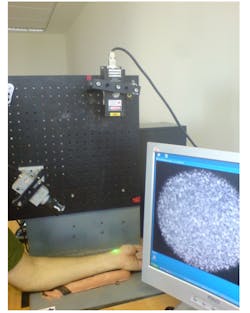BIOPHOTONIC INSTRUMENTATION: Optical 'skin vibration' signature yields biological parameters

Noninvasive, photonics-based blood glucose monitors for diabetes sufferers are being developed that use techniques such as optical coherence tomography (OCT) and Raman spectroscopy. But an even simpler optical technique based on analysis of skin reflections is being developed by researchers at Bar-Ilan University (Ramat-Gan, Israel) and the University of Valencia (Valencia, Spain) that not only monitors blood glucose concentration but also provides heart rate, blood pulse pressure, and information on other biological parameters such as cell-contraction processes.1
Secondary speckle
When human skin is illuminated by a laser beam, the movement of blood under the skin manifests itself as vibrations at the skin’s surface. These vibrations create a secondary optical speckle pattern that correlates to the blood flux, which depends on blood viscosity (related to glucose concentration), blood pulse pressure, and heart rate.
A few-milliwatt infrared (IR) laser at 1550 nm is used to illuminate the wrist of a patient at an oblique angle (see figure). The vertical-reflection speckle pattern is collected by an optical system that consists of a fast camera to record the reflected intensity pattern. The temporal trajectory of the reflected speckle pattern is extracted by image-processing algorithms involving computation of the temporal shifts and random movements of the speckle pattern. A plot of the two-dimensional (2D) position of the captured intensity-distribution pattern over time correlates very well to individual heartbeats.
The temporal data show both the magnitude and direction of the local surface displacement of human skin to nanometer accuracy—a vibration profile that can be used to obtain heart rate, blood glucose concentration, and blood pressure in excellent agreement with nonoptical methods.
Although the distance between the light source and the subject’s skin was approximately 50 cm in the measurement setup, the researchers say they can also extract these biological parameters when the laser-skin distance is several-hundred meters. In addition, the parameters could be obtained not only from wrist-skin reflections, but also from chest and neck reflections.
Bar-Ilan University professor Zeev Zalevsky says, “The developed technology is a very promising technological platform to be used for many additional biomedical applications that are currently being investigated by the research team. One important application that has already demonstrated promising preliminary results is remote monitoring of intraocular pressure, a very essential parameter to glaucoma patients.”
REFERENCE
1. Z. Zalevsky et al., “A novel technique for remotely monitoring key biological parameters,” SPIE Newsroom, http://spie.org/x48866.xml?ArticleID=x48866 (July 12, 2011).

Gail Overton | Senior Editor (2004-2020)
Gail has more than 30 years of engineering, marketing, product management, and editorial experience in the photonics and optical communications industry. Before joining the staff at Laser Focus World in 2004, she held many product management and product marketing roles in the fiber-optics industry, most notably at Hughes (El Segundo, CA), GTE Labs (Waltham, MA), Corning (Corning, NY), Photon Kinetics (Beaverton, OR), and Newport Corporation (Irvine, CA). During her marketing career, Gail published articles in WDM Solutions and Sensors magazine and traveled internationally to conduct product and sales training. Gail received her BS degree in physics, with an emphasis in optics, from San Diego State University in San Diego, CA in May 1986.